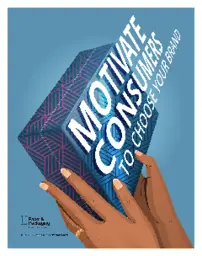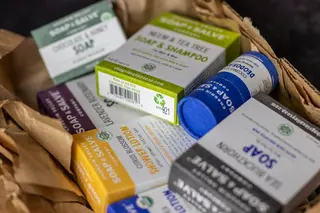
Our decision to buy doesn’t always begin in the brain. Sometimes it starts with our fingers.
At least, that’s the promise of sensory marketing. In this emerging discipline, sometimes called neuromarketing, businesses use the five senses to create an interaction between customer and product, the hope being that a sensory reaction will deepen customers’ devotion. At its most literal, it’s a scratch-and-sniff sticker on a bottle of body wash—but the subtler promises of sensory marketing are getting packagers’ attention.
“Nobody thinks that just touching the texture of packaging is going to change the way they look at the product,” says Luca Cian, a professor at the University of Virginia who specializes in sensory marketing. “They believe they’re making rational choices. But unconsciously, those things affect decision-making.”
Think you’re immune to sensory marketing? Listen to the sounds of paper that shape your day.
Packaging lives in the physical world—that is, the world of the senses—making it prime territory for neuromarketing techniques. Sense organs (like ears and eyes) “catch” stimuli in our surroundings and transmit them to sense receptors (like mechanoreceptors in the inner ear). These receptors convert stimuli into electrical signals, then send them to the brain, which processes those signals into information like “that sound is soothing.”
It’s that last bit—our brains turning kinesthetic input into information—that sensory marketing leverages. When you pour a bowl of cereal, you’re having a sensory experience even before you taste it: You see the images on the box, you hold the carton in your hands, you feel the paperboard under your fingers and hear the characteristic flap as you open the box. You might even catch a pleasant scent; researchers have detected compounds in cardboard that release faint vanilla and woodsy smells.
It’s enjoyable, but what drives purchasing is evaluative conditioning, or the associations we make with experiences. Just as Pavlov’s dogs learned to associate the sound of a bell with mealtime, pet owners know that shaking a bag of pet food will perk up furry ears. Humans aren’t all that different—the sound of that cereal box can make people look forward to diving into its contents.
Evaluative conditioning isn’t the only psychological phenomenon that makes paper packaging a dynamic neuromarketing force. Merely touching a product makes consumers likelier to buy it, says Joann Peck, a professor at the Wisconsin School of Business who researches haptics in marketing. “It feels like it’s yours, even though you don’t legally own it. You physically control it, and that makes you value it more,” Peck says. A 2013 study found that participants rated the feel of paper as more pleasant than plastic and aluminum—even velvet.
The qualities you perceive from the feel of a product’s packaging can transfer to the product itself. For example, people rate goods in heavier packaging as having a more intense smell, and food products as being more filling. When a package’s texture echoes its contents—like oatmeal cookies housed in paperboard with an embossed finish—people report greater satisfaction with the product.
The strategic use of images, colors and typography can elicit sensory marketing experiences—beverage packaging in a bold hue can make people expect a bold flavor, and round shapes are associated with sweetness. Paper substrates support the high-quality printing that allows visual neuromarketing to flourish.
“Companies are starting to pay more attention to sensory marketing, but it’s still new,” Cian says. “People don’t believe commercials anymore. If you say, ‘Buy me because I’m good,’ I say, ‘Why should I believe you?’ But if the product itself is able to convey the ideas you want to express—the touch, the visuals, the sound—it seems subtle. And that subtlety is what’s going to persuade you.”
Learn more about Packaging, as well as the added benefits and solutions from our other industry associations on our Association Partners page.
View Association Partners




